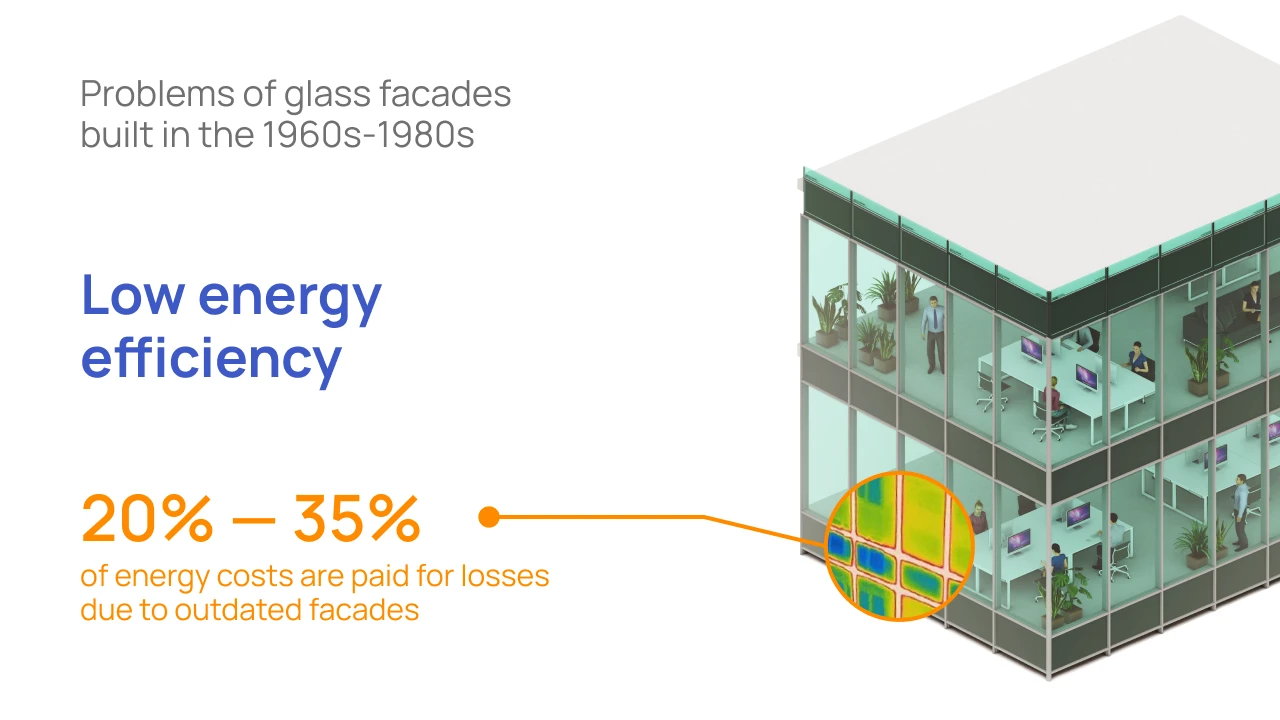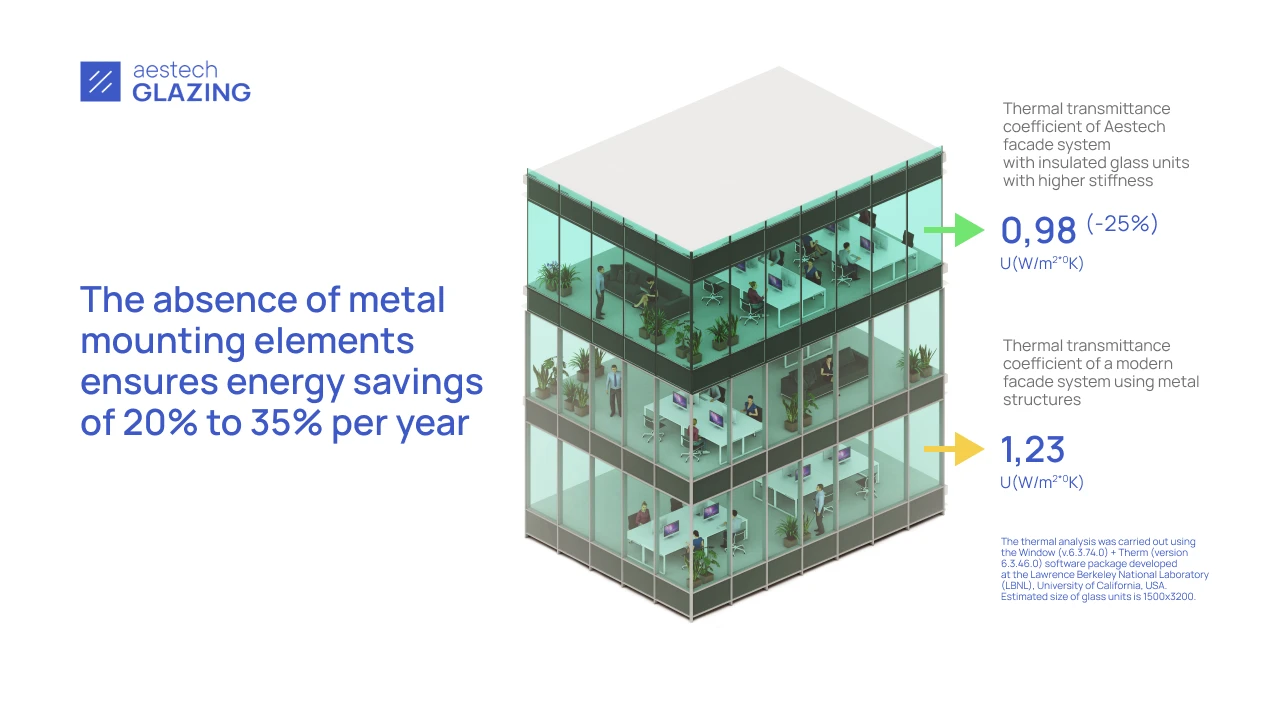The Future of Glass Skyscrapers
How Aestech technologies help solve a global infrastructure problem.

Aestech News
Skyscrapers are one of the most controversial architectural phenomena. Some praise them for their overall impact on architecture, their role in changing approaches to construction, influence on building functionality, and their way of perceiving urban environments. However, there are also critics. Most of their concerns are related to the desire to ensure a more balanced and sustainable development of cities and urban spaces. Without a doubt, tall buildings have become symbols of progress, economic growth, and success, ultimately taking their place in the history of architecture and pop culture.
A century later, it became evident that magnificent and innovative buildings with glass facades started to transform into a problem. In this article, we will discuss why facade modernization is inevitable and how Aestech technologies can help facilitate it quickly and efficiently, saving both time and resources.
Why do facades need modernization?
It is commonly believed that the service life of glass facade systems ranges from 20 to 30 years. Beyond this point, they begin to degrade. The same applies to sealants, gaskets, and other components that are essential for the functionality of glass panels.
Let's not even mention systems from the mid-20th century. Some of them were designed before the invention of a glass unit with two layers of glass. Terrible energy efficiency, compensated by the availability of energy resources and the heavy use of air conditioning systems, moisture penetration, and air leakage are typical but far from the only shortcomings of these older systems.
Ultimately, all of these factors have led us to the brink of a fundamental infrastructure problem today, as there are thousands of such buildings around the world. This issue is particularly pronounced in North America, where glass high-rises began to emerge over a century ago. Today, they require immediate renovation due to their low operational performance, as well as new environmental standards and high competition in the rental market. However, even with all these incentives, modernization does not always become a widespread practice.
It's worth noting the technical complexity of modernization itself. Old facade solutions are often either impossible to upgrade with existing tools or require a significant amount of resources. Frequently, additional repair work is necessary before the modernization process begins, increasing the project's duration and overall costs. This, in turn, is a significant factor that deters property owners.

Aestech Glazing technology can be an effective tool to address this problem. Insulated glass units with higher stiffness (IGUHSs), which are the basis of the frameless glazing technology, do not require additional structural elements like mullions or ridges. They are simply connected to the frame using GRP profiles, which significantly increases the flexibility of the solution, making it applicable to various types of structures without the need for additional preparatory work.
One of the key differences between insulated glass units with higher stiffness and regular glass units is their structural design. In IGUHSs, all layers of glass are rigidly bonded together. This unique feature allows them to withstand significantly higher wind, snow, and other types of loads, as all layers contribute to the structural support. IGUHSs also offer better sound insulation and, thanks to their fastening method, improved seismic resistance.
Competition as a driving force
One of the driving forces is the increasing competition in the rental market. For potential tenants, the logic is clear: the more modern, comfortable, and energy-efficient your building is, the more likely they will choose it for their business.
Today, competition in this sphere is higher than ever. According to a report from NAR, currently, 13.3% of office spaces in the United States are vacant. In a highly competitive market, such as New York, with over three hundred skyscrapers and several more under construction right now, adding approximately 15,000 square feet of space, the uncertain future of the rental market further complicates the situation. About 65% of rental agreements in the United States expire within the next five years.
Modernization of facade systems can become a factor that helps property owners win the competition. An updated facade increases the price per square meter and makes the building more attractive to potential tenants. We discussed why this happens and how glass specifically impacts the workspace in this article.
Restrictions and bureaucracy
The heart of modern megacities, where the tallest buildings are typically concentrated, can be described as a logistical nightmare. Narrow streets with constant traffic, strict regulations, and bureaucracy. Every step requires a permit, and every iteration must be approved. While this is unquestionably right in terms of procedure and order, it greatly slows down the process, leading to additional costs.
It's understandable why property owners might want to delay the moment of modernization. When they commence renovations, they voluntarily forego profits for several months or even years. The building "comes to a standstill," occupied by construction workers, surrounded by scaffolding, enclosed in netting, and the process begins.

With Aestech Glazing technology, this process is radically simplified. The system's modernization can be carried out with maximum flexibility and precision. No additional equipment is required on-site, such as cranes, scaffolding, or other attributes commonly associated with standard processes. All facade replacement work is conducted from within the building and does not disrupt the normal functioning of the structure. Adjacent floors do not feel the proximity of the installation work. Thus, floor by floor, the entire building's facade can be modernized.
New energy efficiency requirements
In 2019, the New York City government began working on one of the most radical pieces of legislation. Local Law 97 is an ambitious plan by the city's authorities to reduce emissions by 80% by 2050. The implementation of this law will occur in two phases. New restrictions will come into effect as early as 2024 and will become progressively more stringent each year. Correspondingly, the fines will increase. From 2025 onwards, building owners will be required to regularly provide reports on emissions and building energy efficiency.
According to expert estimates, next year, between 20% to 25% of buildings will already exceed emission limits. When comparing the current situation with the 2030 limits, this figure will be even higher, ranging from 75% to 80% of buildings.

Glass units can serve as a response to the stringent requirements for building energy efficiency. A key feature of Aestech technology is the absence of mullions and ridges in the facade system.
By eliminating metal, we have made the facades significantly more energy-efficient, as metals, particularly aluminum, have high thermal conductivity. Building owners can save from 25% to 40% annually on energy expenses.
Reducing energy costs is not the only financial benefit of modernization. According to the new laws, starting in 2024, every ton of emissions above the norm will cost building owners $268. For an excess of 1,000 tons, you would have to pay over a quarter of a million dollars. By 2030, this amount will increase by more than threefold.
We are only at the beginning of a great journey that thousands of buildings worldwide will have to undertake. However, technological progress is steadily leading us toward a sustainable architectural future, and Aestech is fully committed to this process.







